TOKYO JAZZ FESTIVAL 2006 - ARTISTS
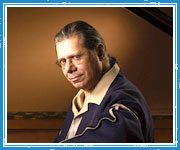
CHICK COREA
Considering the staggering volume of his recorded output over the past 40 years, it is no overstatement to call Chick Corea one of the most prolific composers of the second half of the 20th century. From avant-garde to bebop, from children's songs to straight ahead, from hard-hitting fusion to heady forays into classical, Chick has touched an astonishing number of musical bases in his illustrious career while maintaining a standard of excellence that is simply uncanny. A restlessly creative spirit, he continues to explore and generate new material for a number of different vehicles, including his dynamic Electric Band and his flamenco flavored Touchstone band. Other recent projects include The Ultimate Adventure, the second in a series of evocative recordings based on the writings of his favorite author and longtime inspiration, L. Ron Hubbard, and a new piano concerto which he will premiere in Austria on July 1, 2006 (shortly after his 65th birthday) as part of the gala Mozart Year Vienna festivities being held in the birthplace of the immortal composer.
"I decided when I was a young man to make it as my primary policy to always keep myself interested and challenged with music," says the Grammy Award winning pianist-composer-bandleader. "I've managed to avoid falling into the habit of doing the same thing over and over again, and it's really proved to be a good thing for me. I don't care about the other things, I care that I'm having a lot of fun and creating. So I feel honored or lucky to be able to continue to do that and be able to make a living doing it."
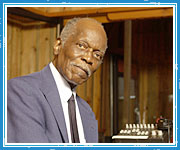
HANK JONES
Born on July 31, 1918 in Vicksburg, Mississippi, Jones grew up in Pontiac, Michigan. He is the eldest of the famous Jones brothers (the second son Thad was a trumpet player and composer while the youngest brother Elvin was a drummer). Not only did Jones begin local performances in his teens, but he is also the founding artist of the Detroit school of pianists represented by Tommy Flanagan, Barry Harris, and Sir Ronald Hanna. Recognized as a rising star by Hot Lips Page, Jones moved to New York in 1944. At the same time he was performing with Coleman Hawkins and Billy Eckstine, Jones was also absorbing the elements of the then-developing Bebop style. From 1947 he participated in Jazz at the Philharmonic (JATP). Between 1947 to 1953 Hank Jones served as Ella Fitzgerald's accompanist and performed with the likes of Charlie Parker. In the 1950's he played with Benny Goodman, Lester Young, and Cannonball Adderley. Jones became a staff musician for CBS in 1959, and for
the next 17 years continued to work with music for radio and TV programs while engaging in other activities. The formation of The Great Jazz Trio in 1976 once again put Jones at the forefront of jazz and thereafter he played an important part in the cutting of numerous albums ranging from supporting roles to a star performer.
Respect for his elegant and smoothly-flowing style as well as his ability to memorize no less than 1,000 standard pieces earned him the moniker "Mr. Standard". Jones is also known for the piano accompaniment of actress Marilyn Monroe when she sang Happy Birthday to the late President Kennedy at his 45th birthday party held at Madison Square Garden in 1962. Jones appeared in a 1990's Panasonic commercial, in which he not only played "What's New," but also said "Yaru mon da!" (It works great) with an ear-to-ear smile.
The Great Jazz Trio (GJT) by Hank Jones
Established by Hank Jones (piano), Ron Carter (bass), and Tony Williams (drums) at the end of April 1976.
The 1977 live recording "At the Village Vanguard" is said to be one of the best recordings ever.
Hank's younger brother, the late Elvin Jones, plays drums in the album "Autumn Leaves" which was released in November 2002, "Someday My Prince Will Come" released in December 2003, and the yet-to-be-released take "Collaboration." In GJT's latest albums, "'s Wonderful" (VRCL 18822) and "Speak Low" (VRCL 18827), John Patitucci performs on bass and Jack DeJohnette dazzles the listener on the drums. Both albums received the Gold Disc Award from Swing Journal Magazine.
(*"Speak Low" won both the Jazz Disc Grand Award and the Best Recording Award in the High Quality Sound Media category at the 39th competition (FY2005) held by Swing Journal Magazine.)
The GJT is characterized by its audacious choice of personnel: leader and pianist Hank Jones's graceful and fluent style, the contrastingly dynamic performance at which the drummer excels, the exquisite balance with which the bassist supports the sound.
GJT features the elegant and smooth-flowing style of leader pianist Hank Jones, the comparatively dynamic play of the drummer, and the transcendent bassist who supports the group's sound with a subtle balance. It would not be an exaggeration to say that the powerful melody produced by this unusual match of talents continues to surprise and delight.
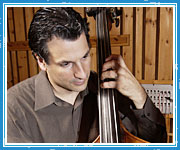
JOHN PATITUCCI
John Patitucci was born in Brooklyn, New York, on December 22, 1959. He began playing bass at age 11. His talent was recognized in the early 1980's when collaborating on works with Tom Scott, Robben Ford, Stan Getz, and other well-known artists in Los Angeles. In 1985, he was selected to receive the honor of becoming a member of Chick Corea's band. Patitucci currently participates and collaborates with numerous artists such as Wayne Shorter. His superb virtuosity in mastering both the acoustic and electric bass is widely recognized in the music industry.
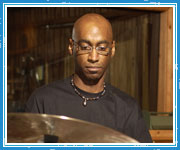
OMAR HAKIM
Omar Hakim was born in New York in 1959. His father, Hasan Hakim, played the trombone in the bands of Duke Ellington and Count Basie, and Omar began playing drums at age 5. In 1980 he made his professional debut be joining Carly Simon's band, and from 1982 to 1985 he was the drummer for Weather Report. Hakim has collaborated on projects with Miles Davis, David Sanborn, John Scofield, and many others. He also has actively participated on stage and in the studios of pop artists like Sting, David Bowie, Madonna, Mariah Carey, and Celine Dion.
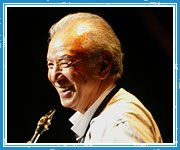
SADAO WATANABE
Born in Utsunomiya on 1 February 1933, Watanabe is one of Japan's top musicians. At age 18, he moved to Tokyo and played with many bands such as Toshiko Akiyoshi's Cozy Quartet. Then, he went to the Berkeley College of Music, where he developed his unique style that does not limit itself to the boundaries of jazz. He now performs all over the world.
In recent years, Watanabe has extended his role in the music scene even more. He instructs at a rhythm school for middle school students and he performs with student bands. He also plays Bach compositions at performance halls. He has gained popularity as a photographer as well, through his 6 photo essays. This year marks his 55th anniversary as a musician.
Watanabe also gained reputation for his notable contribution to the EXPO 2005 AICHI, JAPAN. He served as the all-round director of the government's exhibitions project. In particular, Watanabe fulfilled his life-long dream of integrating music and rhythm that transcend the boundaries of nations and culture by directing such events as "Japan Day Japan Week" and "Sadao Watanabe Rhythm World," featuring 400 children from around the world.
In fall 2005, Watanabe was awarded the Order of the Rising Sun for his various contributions through music. A live recording of his club event "Bona & Sadao," was released in May, titled "One for You/Sadao & Bona Live." A world tour is planned for this fall to promote his new album.
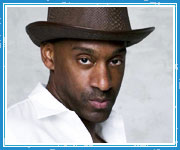
MARCUS MILLER
Marcus Miller, winner of the Grammy Award for Best Contemporary Jazz Album of 2001, was born in Brooklyn in 1959 and raised in Jamaica, New York. He came from a musical family and was influenced early on by his father, a church organist and choir director, as well as his musical extended family (which included the extraordinary Wynton Kelly, jazz pianist for Miles Davis during the late fifties and early sixties!). He displayed an early affinity for all types of music. By the age of thirteen he was already proficient on the clarinet, piano, and bass guitar and had begun composing music. The bass guitar, however, was his love and by the age of fifteen, he was working regularly in New York City with various bands. Soon thereafter, he was playing bass and writing music for flutist Bobbi Humphrey and keyboardist Lonnie Liston Smith.
Miller spent the next few years as a top call New York studio musician, working with Aretha Franklin, Roberta Flack, Grover Washington Jr., Bob James and David Sanborn, among others. He has appeared as a bassist on over 400 records including recordings by artists as diverse as Joe Sample, McCoy Tyner, Mariah Carey, Bill Withers, Elton John, Bryan Ferry, Frank Sinatra, and LL Cool J.
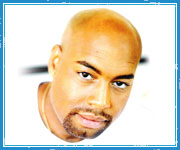
FRANK MCCOMB
Frank McComb is a divine soul man who speaks with the native tongue of blues, jazz, gospel, pop and some hip hop. His virtuoso piano and organ work have made him not only an indispensable and highly sought after session musician, but an underground favorite on the soul and jazz scenes. He has recorded or performed with many of music's giants including Prince, Frankie Beverly and Maze, Teena Marie, Chaka Khan, Lalah Hathaway, Terri Lynn Carrington, Phyllis Hyman and Teddy Pendegrass. He has also done double duty music directing starting his career with Gerald Levert's Rude Boys (Written All Over Your Face) and with pop diva Anastacia.
It was Frank's performance with Prince, the NAACP's Lifetime Achievement Award Winner on the 2005 telecast that thrust Frank back onto a world-stage. This night served as an introduction for some, but a re-emergence for many fans who had never seen one of their favorites live.
Holding down his first jazz trio at 17, Frank McComb has been a music master since he first tickled the ivories at age 12 under the tutelage of an aunt. Frank counts Herbie Hancock and Oscar Peterson as musical heroes. After one listen you can also throw Stevie Wonder, Donny Hathaway and Chick Corea into the potpourri of influences heard through Frank's various bodies of work.
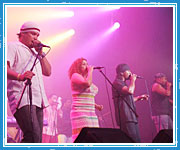
LOS VAN VAN
Formed in 1969 by Juan Formell, Los Van Van are the world's premier Latin dance band, masters of the songo rhythm they invented: a type of music stemming from fusions of Cuban rhythms with synthesizers, all types of rock, rap, Brazilian music, merengue, and just about anything else that caught Formell's interest.
After the revolution, Cuba adopted the Soviet strategy of testing young children for a variety of aptitudes including musical talent and offering promising students conservatory training from an early age. While this important seed began to grow, the existing generation of adult musicians began listening to American music in earnest and absorbing the influences of jazz and the explosion of creativity in rock & R&B in late 60's and early 70's. The most important of these, and probably the most important figure in the history of Cuban music, was Juan Formell, who was the musical director of Orquesta Revé when he and a number of other members broke away to form, in 1969, Los Van Van, a band who has remained Cuba's most popular group for more than 30 years and today is the world's premier Latin dance band, masters of the "songo" rhythm they invented. Los Van Van are not a fearsome collection of virtuoso players like NG La
Banda, but bassist/founder Juan Formell is an ace composer/arranger of dance grooves, and even sneaks in a moving ballad from time to time.
Juan FORMELL (Director,bs,Cho.), Manuel LABARRERA(conga), Julio NOROÑA (guiro), Mario RIVERA "Mayito" (vocal), Samuel FORMELL(drum),Abdel RASALPS "Lele" (vo.), Yenisel VALDÉS "Jenny" (vo.), Roberto HERNÁNDEZ(Vo.Conga ),"Guayacán" (vocal,conga), Álvaro COLLADO(Tb), Jorge LELIEBRE(Fl,Cho.), Edmundo PINA "Mundo"(Tb), Irving FRONTELA(Vn), Hugo MOREJÓN(Tb,Org,Syn), Pedro FAJARDO(Vn), Pavel MOLINA (Cb), Boris Luna(p)
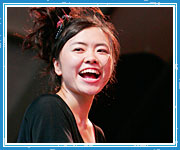
HIROMI UEHARA
Pianist/composer Hiromi mesmerized the jazz community with her 2003 Telarc debut, Another Mind. The buzz started by her debut album spread all the way back to her native Japan, where Another Mind shipped gold (100,000 units) and won the Recording Industry Association of Japan's (RIAJ) "Jazz Album of the Year" Award. Hiromi's second release, Brain, followed a year later. Brain received Swing Journal's "New Star Award," Jazz Life's "Gold Album," HMV Japan's "Best Japanese Jazz Album" and the Japan Music Pen Club's "Japanese Artist Award." When Swing Journal announced the results of its 2005 Readers Poll, Brain won "Album of the Year." Hiromi takes it up another notch with her January 2006 release, Spiral.
Born in Shizuoka, Japan, in 1979, Hiromi took her first piano lessons at age six. She learned from her earliest teacher to tap into the intuitive as well as the technical aspects of music.
"Her energy was always so high, and she was so emotional," Hiromi says of her first piano teacher. "When she wanted me to play with a certain kind of dynamics, she wouldn't say it with technical terms. If the piece was something passionate, she would say, 'Play red.' Or if it was something mellow, she would say, 'Play blue.' I could really play from my heart that way, and not just from my ears."
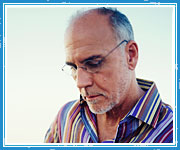
LARRY CARLTON
Larry Carlton was born March 2, 1948, in Torrance, California. He was taught by Slim Edwards from age 6 to 14. He studied jazz guitar several times with Joe Pass. After studying at Harvard College in Los Angeles from 1966 to 1968, and California State University, Long Beach from 1968 to 1970, he won first place for soloist at the Southern California Big Band Contest held in San Diego. In 1969 at the tender age of 21 he went on to release his first album. Carlton joined The Crusaders in 1972 and while performing on the album "Crusaders I," he released his own project "Singing/Playing." Carlton's reputation continued to grow as he performed on eight pieces with The Crusaders all the way through "Free as the Wind" (Universal Music). While participating in Crusaders activities, Carlton made a name for himself as a fusion music session guitarist. His participation on many A.O.R. (Adult Oriented Rock) related popular pieces with Michael Franks, Steely Dan, and others only further entrenched his talents in the industry.
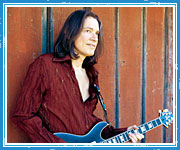
ROBBEN FORD
Robben Ford was born in Woodlake, California, on December 16, 1951, and raised in Ukiah. His entire family has a strong musical background: both parents were professional musicians, Patrick, the oldest of four siblings is a drummer, the second son, Mark, is a blues mouthharp player, and the third son, Robben, started his carrier as a sax player. Swept away by the blues of Mike Bloomfield, Robben picked up the guitar at age 13. After high school graduation, he moved to San Francisco and with his two brothers formed the Charles Ford Band, named after their father. After performing with several blues bands, Ford joined the Jimmy Witherspoon Band in 1972. He began his career as a professional by performing at the Monterey Jazz Festival on the West Coast. You can hear how he played at that time on "Robben Ford: The Blues Collection" (Blue Rock'It). In 1974, after moving to Los Angeles, he appeared with sax player Tom Scott's L.A. Express. While moving to the forefront of his profession as tour support for Joni Mitchell and George Harrison, Ford became interested in jazz when he listened to Miles Davis and John Coltrane. In 1976 he began his solo career with his first album "Schizophonic" (Avenue Jazz), in which he also played the saxophone for several numbers.
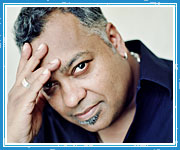
INCOGNITO
Having only recently released the masterpiece collaboration with George Duke in 2004, Incognito have already completed a new album. It is neither a remix album nor a live album, but their 11th original release. With core fans clamouring that it looks to the tremendous successes of the 1990s, Bluey once again throws in one of his trademark sharp catch-phrases, saying "Packed with that authentic Incognito sound, this is our best work, our definitive recording!" When accompanied by album guest feature acid jazz songstress Carleen Anderson, it is plain to see the confidence they gain from the collaboration, and the enthusiasm they pour into live shows. In addition to Incognito's regular feature vocalist Maysa Leak, top UK guitarist Tony Remy is also on board. Apparently Incognito will not shy away from getting the whole family together, if it is for the launch of such a definitive work of soul and funk..
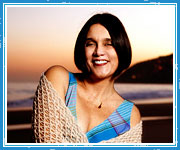
JOYCE
Joyce was born in Rio de Janeiro, Brazil. Known as the muse of the bossa nova second-generation or "post-bossa-nova generation," she is one of Brazil's representative singer-songwriters. Joyce debuted in Rio's International Song Festival in 1967. Subsequent to the release of her 1968 debut album "Joyce"and by "Encontro Marcado" in 1969, Joyce took a five-year break from the stage light to enjoy her new married life. In the mid 70s she danced to the forefront of the music scene with a tour of invigorating and moving performances through Argentina, Uruguay, and Europe. In 1979, Brazil's famous songstress Ellis Regina made Joyce's composition "Essa Mulher" (That Woman) a big hit, bringing Joyce into the singer/songwriter limelight. In the 1980s, she released an ambitious production combining a collection of hits by Antonio Carlos Jobim and Vinicius de Moraes.
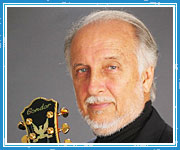
ROBERTO MENESCAL
Guitarist, composer, arranger, and producer Roberto Menescal was born on October 25, 1937 to a family of engineers and architects in Vittorio in the state of Espirito Santo, which is sandwiched between the states of Bahia and Rio de Janeiro. Ignoring his parents' concerns, from a very earlier age he became skilled with a variety of instruments ranging from the nylon-string guitar, to the piano, as well as the accordion. Menescal took lessons in harmony and composition, idolizing American jazz guitarists like Barney Kessel. When Menescal met Carlos Lyra in high school, the two decided to start up a guitar classroom. Among the first students to rush to their class was Nara Leon. was Around the same time Ronaldo Boscoli, who before long would be playing together with Menescal in a well-known combo, began taking lessons with the other youth who joined the classes. Mid-1957 saw the emergence of Joan Gilberto, who was in the process of developing his own original style. Menescal, moved by the refreshingly unique guitar sound and lyrical style, took on the role of assisting Joan to explore further possibilities, and then went on to cultivate his own personal style of playing. In addition to befriending Antonio Carlos Jobim and Vinicius de Moraes, Menescal continued to display his talents at the heart of the circle that gave birth to the genre we know as bossa nova. When bossa nova exploded onto the scene in the 1960s, Menescal was performing with young artists like Eumir Deodato, and in 1962, he took part in the Bossa Nova Festival held at Carnegie Hall in New York City.
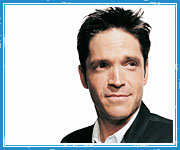
DAVE KOZ
A long-awaited first leader session in Japan by America's No.1 saxophonist renowned for drawing out smooth jazz sounds that are easy to dance and listen to.
Although the play list consists entirely of instrumental sax pieces, Koz's melodious and catchy numbers pierce the soul, giving listeners the distinct impression that someone is actually singing. While it seems that instrumental albums in the U.S. tend to get a cold shoulder in the popular market, listening to the music of Dave Koz will immediately prove the exact opposite. Most experts who witnessed Koz's public performance this past March voiced astonishment in this regard. Using multiple leads, he is without a doubt No. 1 in the smooth jazz genre. In addition to being very active in radio performances, Dave Koz is also involved as vice president and artistic director of a record label. When Koz stands on stage with a saxophone in hand, he goes straight to the heart of the music with his unique and characteristic technique. This performance will be his long-awaited first leader session in Japan.
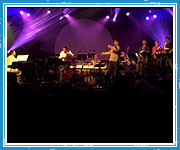
TRONDHEIM JAZZ ORCHESTRA
Atle Nymo(T.Sax), Frode Nymo(A.Sax), Tor Yttredal(A & S.Sax), MoesterKjetil(T.Sax), John Paal Inderberg(B.Sax), Eivind Nordset Loenning(Tp), Tore Johansen(Tp), Oyvind Braekke(Tb), Inge H. Mortensen(Horn in F), Hans Christian. Froenes(Gt), Erlend Skomsvoll(Conductor), Andresen & Traeldal(Tp), Steinar Raknes(Ba), Haakon Mjaaset Johansen(Dr), Oeystein Baadsvik(Tuba)
The foundation Midtnorsk Jazzsenter(MNJ)has, since the formation in 1997,had as one of its main objectives to establish a big professional jazz band based on the unique jazz performing milieu that exists in Central Norway;-a Trondheim Jazz Orchestra. The concert with Chick Corea in the year 2000 at the Molde International Jazz Festival was an important milestone in this work and an excellent work of how Norwegian arts politics may lead to concrete artisitic results on a high level. This year,the Trondheim Jazzs Orchestra will be performing, again , with Chick Corea for the first time in Japan.
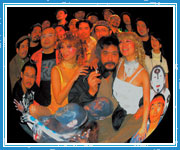
SHIBUSASHIRAZU ORCHESTRA
ShibusaShirazu was formed in Kichijoji in 1989, led by leader Daisuke Fuwa, who was in charge of music to accompany a play performed by the theater group Hakken no Kai.
The stage performances put on by this band go beyond any single genre, mixing together jazz, rock, Latin, folk, and even Japanese enka. This blend of music is accompanied by butoh dancing and stage art, creating a show that is both unconventional and delightfully entertaining.
It is experiential entertainment put on by an incredible underground, subculture group.
In 1998 its coolness invaded Europe.
Having toured in Europe four times, the band was repeatedly invited to play in the Moers New Jazz Festival in Germany, internationally known as a festival for avant-garde music. At the 2000 event, ShibusaShirazu put on an amazingly successful finale for the main stage, having to turn away eager fans since the giant circus tent had become completely filled up.
It is said that this show had every musician in New York talking about it within a week.
The group was also invited to perform as one of the feature acts at England's Glastonbury Festival in 2002.
Domestically, it has played for four years in a row at the Fuji Rock Festival starting in 2001, and also appeared in the Rising Sun Rock Festival in 2004.
Their European tour in 2005, turned out to be an intense journey which lasted around five months involving 45 performances at 29 locations throughout East and West Europe.
The group is a world-class Japanese music troop that cannot be placed in any single category. Constantly pulling in the audience with its overpowering performance, they have consistently captivated not just music fans but people from all walks from life including theater and butoh enthusiasts. ShibusaShirazu is a full-scale underground stage performance group.
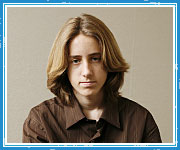
AUSTIN PERALTA
Born on October 25, 1990, Austin Peralta became interested in classical music and began learning the piano at age six. At 10, while learning classical piano he developed an interest in jazz and was instructed by Alan Pasqua (keyboard) and Buddy Collett (tenor sax) while continuing his classic lessons. Peralta claims his greatest influences are Chopin, McCoy Tyner, and Herbie Hancock, and although only in his early teens, he has gained unusual attention as a pianist.
Peralta's trio, The Hour Trio, which released the Indies CD "Inta' Out," has performed at such jazz locals as Catalina's and Jazz Bakery in his home state of California. The trio received the Shelly Mann New Star Award (sponsored by the Los Angeles Jazz Society and Phillip Mann) in 2002. They performed in the Sweet & Hot Music Festival, and then as the opening act to the Tribute to Woody Herman Jazz Festival, in 2004.
In addition to the piano, the multi-talented Peralta plays the upright bass, drums, saxophone, and other instruments. But his talents are not limited only to instruments; Peralta is also a superb composer. In addition to his original recordings released by Indies CD, Peralta's piano solo was used in the 2004 documentary film Riding Giants.
Austin Peralta's first tour to Japan was in the spring of 2006 and since then he has gained worldwide notoriety by performing at events such as the Playboy Jazz at the Rose Bowl (US) on May 29 and Baltic Jazz Festival (Germany) on July 2 of this year.
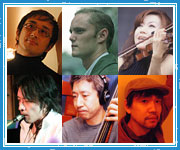
~TOKYO JAZZ PACIFIC ALL STARS Vol.1~
JAPAN AUSTRALIA JAZZ ORCHESTRA
Makoto Kuriya, Cameron Deyell, Ken Ota, Tetsuya Hayakawa Masahiko Osaka, Phil Slater, Matt Keegan, James Greening featuring Naoko Terai
Makoto Kuriya :Music Producer, piano
Cameron Deyell : Music Producer, guitar
Naoko Terai : violin
Ken Ota : alto sax
Tetsuya Hayakawa : bass
Masahiko Osaka : drums
Phil Slater : trumpet
Matt Keegan : tenor sax
James Greening : trombone, didjeridu
These popular and talented musicians from Australia and Japan have come together for the 2006 Australia-Japan Year of Exchange to form this remarkable orchestra. A collaboration that reaches beyond cultures and languages is spreading out across the Pacific, and those who take it in are destined for an unforgettable time.
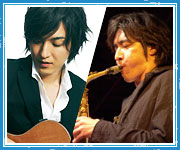
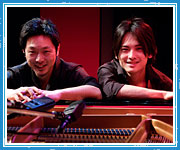
Les Frères
The Yokosuka-born brothers Moriya (older) and Keito (younger) Saito formed the piano unit Les Frères (meaning "brothers" in French) on September 3, 2002. Each of the brothers has his own unique playing style. Moriya is strong in playing ballads, while Keito's area of strength is the boogie style. Adding to these the taste created by the Les Frères unit, the brothers established a "cattlemen's style" (two people playing on one piano) that rewrites the common image of the piano and explodes with overwhelming energy. Their free and dynamic style based on complete mastery made by four hands over one set of keyboard breaks away from the traditional views held toward the piano.
Les Frères stage performances are hot and filled with a variety of soul-stirring original tunes, from fresh boogie-woogie-based improvisation, to pop, to classical. Their melodies will grab the listeners' hearts and refuse to let go.
The two pianists write and play their music with their main focus on wa, or harmony. Their reverberating sounds, which can be described as "balanced," "consonant," or "concordant," are expressed as a form of vibration that travels freely and effortlessly out of the keyboard, stirring the listeners' spirits.
